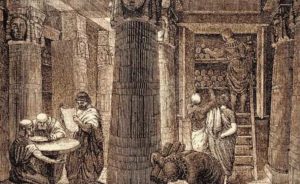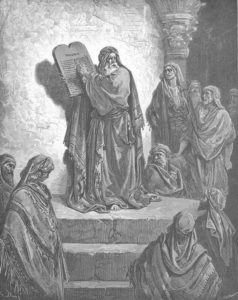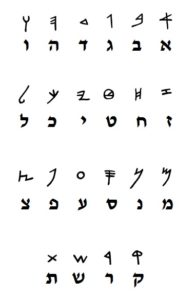Today we mark one of the “minor” fast days of the Jewish calendar: Asarah b’Tevet, the Tenth of Tevet. Technically, in ancient times there were three separate fasts instituted on the eighth, ninth, and tenth days of Tevet. However, because fasting three days in a row is not practical for most people, the three were combined into a single day. None of this is coincidence, of course, and there is a profound connection between the “three” fasts. First, a recap: what does each of these fasts commemorate?
The eighth of Tevet is the traditional date for when the Septuagint was completed. Recall that sometime in the 3rd century BCE, King Ptolemy II Philadelphus (r. 284-246 BCE, and known simply as “Talmai” in Rabbinic texts), gathered a group of Sages to translate the Torah into Greek. We know from historical records that Ptolemy II (who was the Greek ruler of Egypt) established or greatly expanded the famous Library of Alexandria, then the world’s epicentre of scholarship. At one point, the Library held 400,000 different texts and scrolls. For centuries, it was the home for countless scholars, philosophers, poets, mathematicians, and mystics.
Wishing to expand his collection, Ptolemy II started an extensive campaign to populate his library. Not surprisingly, he commissioned a group of rabbis to produce a Greek translation of the Torah. (At the time, Israel was under the control of Ptolemaic Kingdom. Later on, the Seleucid Kingdom wrested Israel from the Ptolemaic Kingdom, leading to the events of Chanukah. It is important to state again that Chanukah was not about Jews battling all Greeks, but rather a specific Syrian-Greek entity. The majority of the Greeks played no role in the conflict. In fact, we know from historical sources that the Spartan Greeks even allied with the Jews!)
A total of seventy (or seventy-two) rabbis were selected for the great task of translating the Torah, hence the name Septuagint, literally “seventy”. In Jewish tradition, the day the work was finished and the text presented to Ptolemy was the eighth of Tevet. The question is: why was this day considered a tragedy? Why must we fast to commemorate it? The tragedy is all the more perplexing when we consider that the Sages actually respected the Greeks, and had a liking for the Greek language.
It isn’t a secret that Greek is based on the Hebrew alphabet (aleph, beit, gimmel, dalet—alpha, beta, gamma, delta, etc.), has its own form of gematria like Hebrew, and that the Sages themselves adopted many Greek words. Rav Yitzchak Ginsburgh writes that in doing so, the Sages “sanctified” those Greek words, and made them holy Torah words (see Breath of Life, pg. 74). He points out some beautiful examples, too. For instance, the Sages adopted the Greek word for a person who has both male and female characteristics—androgynous (אנדרוגינוס). It happens to be that this word has the same gematria (390) as zachar v’nekevah (זכר ונקבה), “male and female”!
Even more telling is a passage in the Talmud (Megillah 8b-9a) suggesting that the Torah, mezuzot, and tefillin can only be written in either Hebrew (with Ashuri script, like we do today, which we will get to), or Greek! Here we also find the history of Ptolemy’s Septuagint:
Tefillin and mezuzot are to be written only in Ashuri, but our Rabbis allowed them to be written in Greek also. But is it not written, “and they shall be?” [Deuteronomy 6:6] I must say therefore, that scrolls of the Scripture may be written in any language, and our Rabbis permitted them to be written in Greek. “They permitted”!? This would imply that it was originally forbidden! What I must say therefore is, our Rabbis permitted them to be written only in Greek. And it is taught that Rabbi Yehuda said: When our teachers permitted Greek, they permitted it only for a scroll of the Torah. This was on account of the incident with King Ptolemy, as it has been taught: It is related of King Ptolemy that he brought together seventy-two elders and placed them in seventy-two rooms, without telling them why he had brought them together, and he went in to each one of them and said to him: “Translate for me the Torah of Moses your master.” God then prompted each one of them and they all conceived the same idea and wrote for him…
A great miracle occurred for those seventy-two rabbis, and the Talmud goes on to state how God made it so that all of them made the exact same changes to the text when translating the Torah into Greek. These changes were necessary to ensure that the Torah would not be misunderstood or misused by the Greeks. If that’s the case, why must we fast? A great miracle occurred! Should we not celebrate instead? To solve this puzzle, we must look to the next fast day, the ninth of Tevet.
Ezra, and Jesus
The reason for fasting on the ninth is something of a mystery. The Shulchan Arukh (Orach Chaim 580) doesn’t give a reason at all, saying it is “unknown”. One of the earliest halachic texts, Halachot Gedolot (dated back to sometime in the 8th century CE) also notes that the Sages did not give an explicit reason for why one should fast on the ninth. However, it then offers that this was the day that Ezra HaSofer, “the Scribe” (and probably also his partner Nehemiah) passed away.
Ezra was a tremendously important figure in Jewish history. He was born in Babylon during the Exile between the First and Second Temples. Ezra studied under Baruch ben Neriah, the disciple of Jeremiah the prophet, and became the greatest sage of the day. He eventually led a group of 1500 Jews back to Israel, and found the Holy Land mostly devoid of Judaism, with its Jewish population unobservant, and many intermarried with non-Jews. Ezra got down to work. He enacted ten decrees to save Judaism, the most famous among them that the Torah must be read on Mondays and Thursdays (which all synagogues still do to this day). He was perhaps the first kiruv rabbi, and successfully brought the Jewish community back to a level of observance not seen since the time of Joshua, the successor of Moses (Nehemiah 8:17).
The Talmud (Sukkah 20a) credits Ezra with restoring Judaism to the Holy Land. It goes even further and states that had Moses not brought the Torah to Israel, Ezra would have been worthy of doing so (Sanhedrin 21a). On that same latter page, the Talmud states that originally the Torah had been written in Ancient Hebrew script. It was Ezra who first wrote the Torah in Ashuri, or “Assyrian” script—the letters that we know today. Others hold that the Torah was originally given in the holy Ashuri font, which does not mean “Assyrian” but me’ushar, “upright”. This font was replaced by a different one for a while, and then restored by Ezra.
The Talmud suggests another interesting thing: Ezra may have been the first person to translate the Torah, for “in the days of Ezra, the Torah was in Ashuri script and in the Aramaic language” (Sanhedrin 21a). So, we mourn when the Torah was translated into Greek, but we don’t mourn when the Torah was translated into Aramaic? Are we not mourning the passing of Ezra—the Torah’s first translator?! On that note, why do we specifically mourn Ezra’s day of death, and not any other great figure or prophet in Jewish history? Thankfully, there is another explanation for the ninth of Tevet…
The above is an excerpt from Garments of Light, Volume Two. To continue reading, get the book here!





Pingback: The Ten Plagues on the Ten Senses of the Human Body | Mayim Achronim
Pingback: Onkelos and the Problem with Translating the Torah | Mayim Achronim
Pingback: Apocrypha, Part 1: Understanding Tanakh | Mayim Achronim
Pingback: Can a Virgin Get Pregnant? | Mayim Achronim
Pingback: Secrets of the Jewish Calendar | Mayim Achronim